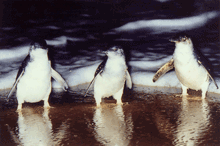
Wilsons Promontory: the southernmost point of the Australian mainland, The Prom is arguably the most loved national park in Victoria. The park contains the largest coastal wilderness area in Victoria. A wild and desolate headland with open heaths, sand dunes, tall forest ranges, tree fern valleys, salt marshes, sandy beaches, islands, reefs and granite headlands, The Prom, as it is affectionately known to Victorians, is just a half day's drive from Melbourne. Mountainous and heavily wooded, it is a wonderful place to fish or observe the abundant flora, fauna and marine life. Walking trails provide access to the gorgeous coastal scenery with a choice ranging from short walks to all-day hikes. For the skilled rock and beach angler, the fishing is good.

![]()
Walhalla: Nestled in the foothills of the Great Dividing Range 46 km north of Moe, the former goldmining town of Walhalla that appears to have been snap frozen in time. Many of its original buildings remain. These include the fire station, museum, post office, Windsor House, Mechanics Institute, bank vault Freemason's Lodge, St John's Church of England and, possibly the most photographed thing in Walhalla, the grand old band rotunda.

|

Phillip Island: just 140 kilometres south east of Melbourne, Phillip Island, is the best place in Victoria to come face to face with the wildlife of Australia. Here you can drive down a road where hundreds of koalas sit dozing in their treetop homes above you; take a look at Australia's largest colony of fur seals, and at night, enjoy watching hundreds of Little Penguins returning to their burrows at the famous Penguin Parade. Phillip Island has some spectacular coastal scenery, being exposed to Bass Strait and the Southern Ocean and boasts such features as Cape Woolamai, the Blowhole, Seal Rocks, the Collonades, The Nobbies, Pyramid Rock and the Pinnacles.

![]()
Buchan Caves: Near the township of Buchan, lies a honeycomb of caves full of spectacular limestone formations. Buchan Caves were formed by underground rivers cutting through limestone rock. The formations are created by rain water seeping through cracks and dissolving some of the limestone. In time, stalactites are formed on the roof of the cave, and stalagmites build up from droplets which fall to the floor.

|
Gippsland Lakes and 90 Mile Beach: Comprising of a network of lakes, marshes and lagoons, The Gippsland Lakes are the largest inland network of waterways in Australia. The Lakes are separated from the ocean by coastal dunes known as Ninety Mile Beach. Bird and marine life thrive here, with lake dolphins and pelicans frequenting many locations. The lakes include many small islands, which are reached easily by ferry or water taxi from Paynesville. There are also two national parks that abut the lakes, the Lakes National Park and the Gippsland Lakes Coastal Park, both of which offer great camping and walking tracks.

![]()
Tarra Bulga National Park: Tarra Bluga National Park is known for its deeply-incised river valleys, giant Mountain Ash trees, beautiful fern gullies and ancient myrtle beeches. The park covers 2015 ha of some of the best examples of original cool temperate rainforests of the Strzelecki Ranges. Roads throughout the area are narrow and winding but offer marvellous scenery with wide views from several points.

|